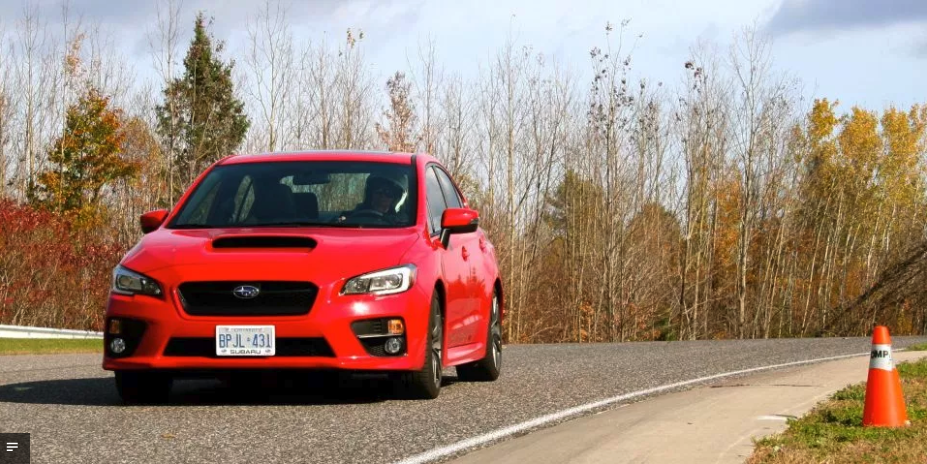Long-Term Test: 2016 Subaru WRX CVT – Part 2

Story and photo by John LeBlanc
CALABOGIE, Ont. — The idea of owning a car with an automatic transmission can be sheer blasphemy to many sports compact fans. Why would you want to detract from the joys of changing gears – and, arguably, not stay in complete control of your vehicle? Yet our latest 60-day test drive subject, the 2016 Subaru WRX, is just such a blasphemous beast.
For the first time in seven years, Subaru is offering an automatic transmission – a continuously variable unit, no less – in its WRX compact sports. And as we questioned in our introductory article, we wondered if the new $29,995 (base MSRP) Subaru WRX sedan with its $1,300 CVT (branded Sport Lineartronic) would be a help or a hindrance compared to the standard, six-speed manual version.
To find out, we returned to familiar stomping grounds, Calabogie Motorsports Park (CMP), a 45-minute drive west of Ottawa, with our CVT-equipped 2016 Subaru WRX tester. We’ll get to how the CVT behaved on the road and on the track, but slushbox or not, the WRX continues to impress as one of the really great affordable performance cars of our time.
Driving the winding Ottawa Valley roads to get to CMP is almost as much fun as the track itself. Although it has evolved into a roomier and more comfortable car, the five-passenger 2016 WRX still has the performance chops to keep sports compact fans happy.
To begin with, the WRX feels as solid as a piece of the Canadian Shield that pops into view around most of the bends in these parts. Eschewing a hatchback design for a more rigid sedan body, torsional rigidity is up 41 percent over the last WRX, which allows for tighter spring rates (up 39 percent upfront and 62 percent out back).
The Subaru WRX’s turbocharged 2.0-litre flat (or Boxer) four-cylinder engine’s 268 horsepower and 258 lb.-ft. of torque quickly gets the four-door moving briskly to Ontario’s 100 km/h maximum road speed. But know that the WRX with CVT takes 5.9 seconds to go from zero to I-didn’t-know-I-was-going-that-fast-Officer, while the six-speed stick is 0.5 seconds quicker.
Also noteworthy: the Subaru’s killer value proposition in its class, all-wheel-drive, makes it not only easier to get launched in a straight line but also offers a better balance of road handling than front-drive-only rivals like the $30,349 2015 Ford Focus ST or $27,995 2015 Volkswagen GTI.
The other advantage the Subaru sports compact has over its wrong-wheel-drive competition is its natural-feeling steering. Twirl the WRX’s thick, leather-wrapped steering wheel and you get knife-like precision and steering effort that loads up as the turn gets tighter. For this average-size driver, the WRX’s diving position is spot-on, and its cloth sport seats are supportive and comfortable.
While we were able to gain access to Calabogie’s 5.05-kilometre long track, we weren’t able to properly time our laps to see if the CVT-equipped WRX was faster than the stick model we drove here last fall. But between the few weeks we’ve already had with the WRX CVT on public roads, and the laps we did get around CMP, we’ve certainly got a better opinion on the pros and cons of the Subaru autobox.
Despite only having one “gear” (actually, two adjustable pulleys and a link-type chain), for the most part, Subaru’s Sport Lineartronic CVT tries to act like a regular torque converter transmission. The Subaru Intelligent Drive (or SI-DRIVE) system that comes along with the CVT offers a trio of engine response modes.
The first two, Intelligent and Sport, have six fake or “stepped” gears. The third and sportiest, Sport Sharp, gives you eight ratios. Steering wheel-mounted paddle shifters are standard too, plus a screen between the speedometer and tachometer displays what gear the CVT is pretending to be in.
On public roads at commuter speeds, the Subaru CVT feels very much like a “normal” slushbox. When accelerating hard, the WRX’s CVT – unlike most CVTs – doesn’t jump to a high rpm and hold it there. Instead, you can feel the unit make its way through either the six or eight preset “gears.” But once we got to the track and started putting the WRX through its paces, the autobox could not deliver the same direct and instantaneous responses the Subaru six-speed manual does.
Even when using the full-on Sport Sharp setting, where the CVT holds revs longer for improved power delivery, there’s always a slight delay before the turbo-four’s prodigious power can be fully realized. Combined with the engine’s slight turbo lag, the WRX CVT always feels like its one step behind where the driver wants the car to be.
For buyers who want all the high-performance goodies the legendary Subaru sports compact is known for, but without the hassle of having to work a clutch pedal, go ahead, get the CVT (just make sure to drive around with the SI-DRIVE mode in Sport Sharp).
However, for sports compact fans who may also end up at a track someday, like here at Calabogie Motorsports Park, it’s hard to argue with the sharper reactions of the WRX’s standard six-speed manual.





![[del.icio.us]](https://www.straight-six.com/wp-content/plugins/bookmarkify/delicious.png)
![[Digg]](https://www.straight-six.com/wp-content/plugins/bookmarkify/digg.png)
![[Facebook]](https://www.straight-six.com/wp-content/plugins/bookmarkify/facebook.png)
![[Google]](https://www.straight-six.com/wp-content/plugins/bookmarkify/google.png)
![[Reddit]](https://www.straight-six.com/wp-content/plugins/bookmarkify/reddit.png)
![[StumbleUpon]](https://www.straight-six.com/wp-content/plugins/bookmarkify/stumbleupon.png)
![[Twitter]](https://www.straight-six.com/wp-content/plugins/bookmarkify/twitter.png)
![[Email]](https://www.straight-six.com/wp-content/plugins/bookmarkify/email.png)